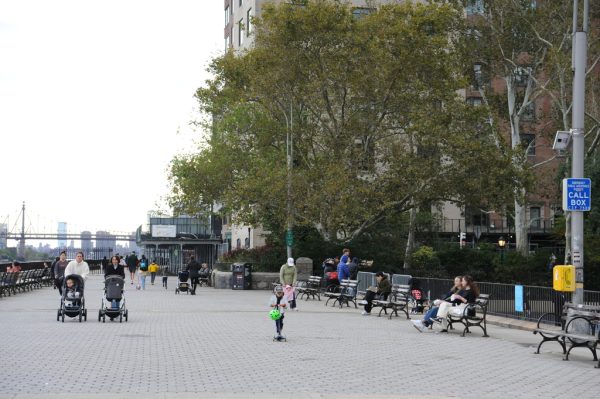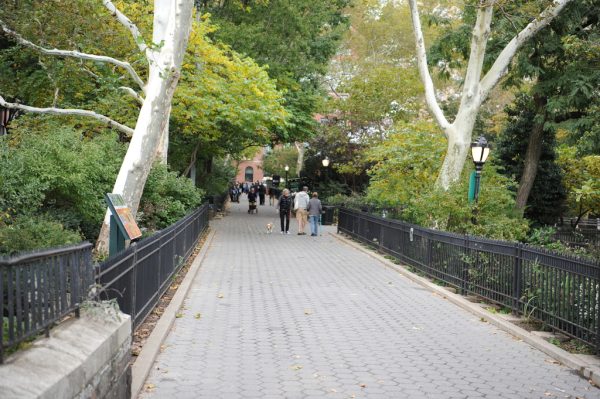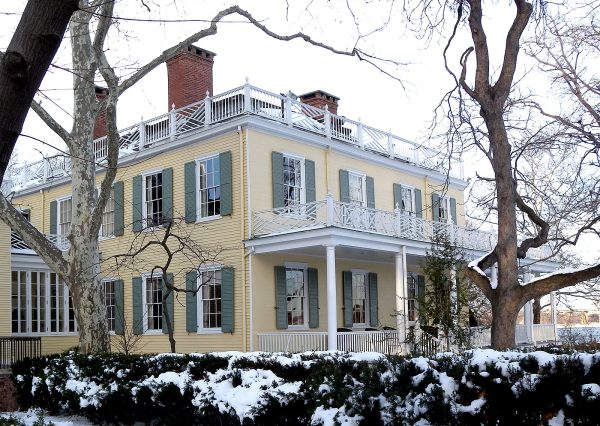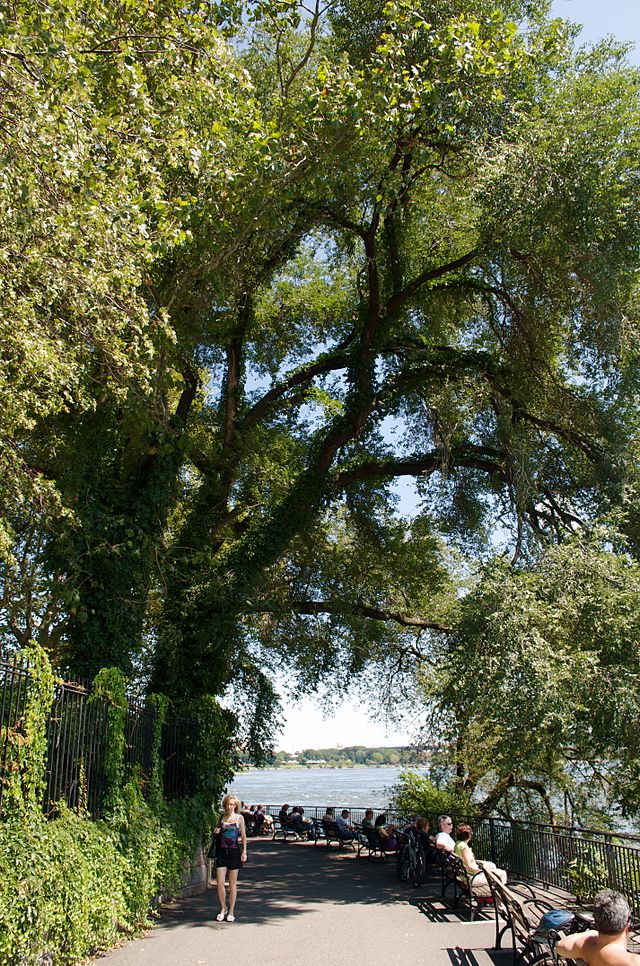On the very edge of Manhattan’s Upper East Side, past the typically quiet streets of East End Avenue, is Carl Schurz Park. At a glance, the park is quaint and unassuming, and for the most part, that assumption is correct. The stone slab and iron fences coated in decades of jet black paint, the overflowing greenery that finds its way through the bars of the fence, and the abundance of budding flowers all give the park its charming and pleasant feel.
Its primary entrance is on 86th Street, where the busy street meets a dead end. The first thing I notice as I walk in is the park’s grandiosity. The stone and steel walls part, forming an entrance as wide as the street. Inside, a large rectangular enclosure houses the true gems: a grove of eighteen Prunus Kanzans, a type of tree commonly known as ‘Japanese flowering cherries,’ or ‘sakura trees.’
As the name suggests, these showy, deciduous trees are native to Japan. Yet, sakura trees can be found throughout the nature reserves of New York City, in places such as Central Park, Roosevelt Island, and Sakura Park. These sakura trees were first introduced to the United States in 1912, when Mayor Yukio Ozaki of Tokyo City gifted the people of the United States 3,020 trees as a token of goodwill between the two nations. A portion of the then infant blossom trees were planted in Washington D.C., and later that same year, the remainder were shipped to New York, and they have since blossomed throughout the city.
Surrounding the elegant tree enclosure are rows of standard park benches, and behind them, are two thick walls of rock on either side. The rocks jut out like cliff faces, leftovers from when the park was first terraformed in the ninteteenth century to form a makeshift plaza.
At the back of the plaza, obscured by the cherry blossoms, lies another significant structure. Two symmetrical, curving staircases that rise up to the East River promenade, encircle the ‘Hoop Garden.’
Unlike the other gardens scattered throughout Carl Schurz, the ‘Hoop Garden’ is not planted with perennials. Instead, it is planted with annuals, providing vibrant floral arrangements that vary from year to year. The garden borders English hedgerows on all sides. Up the stairs is the East River promenade, created during one of the park’s many reconstructions, created in 1935 to accommodate the construction of the F.D.R. Drive below.

Surprisingly, the elevated walkway, less than fifty feet above one of the city’s busiest highways, remains relatively quiet. The wind from the choppy East River drowns out the low growl of car engines.
While the park underwent significant reconstruction in 1935, the origins of the Carl Schurz Park can be traced back more than three centuries. The land was first officially claimed by the Dutch West India Company. Then in 1646, the land was sold to Sybout Claessan, a Dutch farmer and artisan who dubbed it ‘Horn’s Hook,’ paying homage to his home village.
Then, in 1770, Jacob Walton, a wealthy merchant and British loyalist, took possession of the land. However, Walton’s ownership was cut short in 1776 when George Washington seized the land to fortify his army’s position along the East River during the American Revolution.
After the war, in 1798, Walton’s heirs reclaimed their land and sold the plot to Archibald Gracie, a young merchant from Scotland. Gracie then went on to build his family’s home on the property, the renowned Gracie Mansion. Due to financial woes induced by the War of 1812, Gracie was forced to sell the land in 1823. Finally, the city seized the land from Noah Wheaton in 1896 after he failed to pay his property taxes.
In 1910, after the park was opened to the public, it was renamed for the German-American dignitary, Carl Shurz.
Many renowned architects were responsible for the landscaping of the park. Among the most notable were Samuel Parsons and Calvert Vaux. Vaux, a prolific landscape architect, renowned for his work in Central Park, provided the primary naturalistic ideas behind the landscaping of the park. However, he was unable to live to see it come to fruition, tragically drowning in Gravesend Bay, Brooklyn while visiting his son.
Parsons was the founder of the American Society of Landscape Architects and is well-known for his contributions to many of New York’s iconic landmarks, including Central Park. Upon Vaux’s death, Parsons picked up where Vaux left off. He executed the asymmetrical paths, terraced landscape, and naturalist plantings. Parson also focused on enhancing the view of the river through the heavy use of stone along the rim of the park, avoiding any unnatural structures.
“It feels like our neighborhood’s little slice of paradise,” said Shawlini Manjunath, a long-time Upper East Side resident. “Even though the park isn’t that big, it’s structured in a way that makes it feel vast,” said Manjunath.

Aside from the landscaping, perhaps the most important and well-known feature of the park is the Gracie Mansion. Still in use after its construction in 1799, Gracie’s home has functioned as the permanent residence of the Mayor of New York City since the arrival of Fiorello La Guardia in 1942. The two-story sturdy wooden Federal Style estate, described by former mayor La Guardia as the city’s “little white house,” sits at the zenith of the park, overlooking the river.
In Archibald Gracie’s day, the house served to accommodate his extravagant parties and his momentous business meetings. Among the most notable guests Gracie hosted at the mansion were Alexander Hamilton and John Jay. In fact, it was in Gracie Mansion, during one of Gracie’s parties in 1801, where Hamilton began to court investors for his newspaper, the New York Evening Post, which is presently recognized as the New York Post.

(Photo Credit: Jim.henderson, CC0, via Wikimedia Commons)
The house is a faded yellow, in contrast to its stark white window-casings adorned with large pine green shutters. At the base of the small mound the mansion sits atop is a large red brick wall, built to give its part-time residents some semblance of privacy. The wall is covered in long vines, making it exceedingly difficult to catch a glimpse of the house, as intended, adding to the mystique of the storied residence.
Despite the relatively small size of the park compared to other city parks, there never seems to be a dull moment while walking around Carl Shurz. Early mornings greet runners who all seem to share the same serious and purposeful expression. In the afternoon, the park fills with children who flock to the playground in droves. Evenings see teenagers playing basketball, seniors strolling along the promenade, and dog owners dutifully walking their dogs to one of the park’s two dog runs. All of these moments throughout the course of the day enrich the park’s lively atmosphere.
The excellence of Carl Schurz Park can be attributed to the diligent efforts of its dedicated conservancy. The Carl Schurz Park Conservancy is an organized volunteer group that works in conjunction with the Parks Department to “enhance the public’s enjoyment and involvement in the park.” The group was founded in 1974 and was initially tasked with beautifying the park after its reconstruction. Today, the group maintains the same goal of “restoring and beautifying the park,” also boasting the title of the city’s oldest community-based park organization.
In addition to managing the park’s horticultural arrangements and coordinating park clean-ups, the conservancy facilitates community events throughout the year. Annual gatherings such as Christmas caroling, Easter egg hunts, and the Halloween howl, a canine costume contest, leave hardly a holiday unaccounted for.
“I like how it’s tucked away, the park is almost like a little enclave for the community,” said James Holbrook, yet another longtime neighborhood resident. “Especially with my dogs and kids, the park is so great to have. We always attend the movie nights and the little classes hosted at the playground. There is always something happening.”
These events thrown by the conservancy, the historical value of the park, and its natural beauty make it extremely popular among members of the community.
“Personally, I think it’s a little gem that not many people know about,” said Stacey Spanneda, a lifelong resident of the Upper East Side who has frequented the park for over forty years. “It feels like our neighborhood’s little secret; it feels relaxed and local in a way that Central Park just isn’t.”
This love of the local vibe seems to be common amongst Yorkville and Upper East Side residents, myself included.
“Having such a lovely green space nearby is such a gift,” said Manjunath. “I’m originally from Georgia, so I really need that bit of nature, especially in New York, where we’re surrounded by concrete and big buildings. This park has a really restorative nature, and I come here all the time to relax.”
In the midst of the “hustle and bustle” that New York City is known for, the integration of parks and other natural spaces within the confines of the “concrete jungle” cannot be understated. Carl Schurz Park, with all of its charms, is an integral facet of the neighborhood that truly succeeds at bringing people together. As Manjunath put it, “It’s essentially our community’s backyard.”
“It feels like our neighborhood’s little slice of paradise,” said Shawlini Manjunath, a long-time Upper East Side resident. “Even though the park isn’t that big, it’s structured in a way that makes it feel vast,” said Manjunath.

